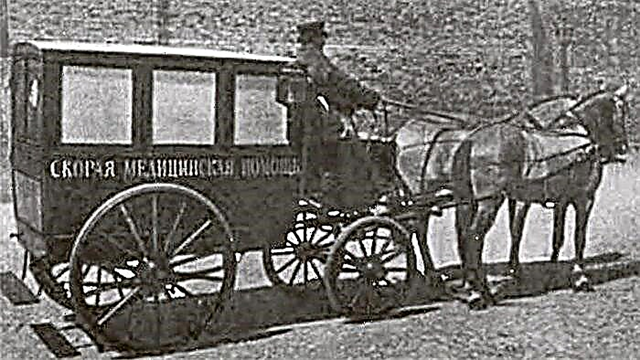
What changes the ambulance has not undergone throughout its history! It was a closed horse drawn carriage, a two-tier carriage, a bicycle wagon, a tracked vehicle, a truck, and a motorcycle. Appearance changes over the years - the name remains the same. Why did this happen? Let's try to figure it out.
Emergence of ambulances in the world
The first ambulance in the world appeared on December 8, 1881, in Vienna, the capital of Austria. Despite the fact that there were many clinics equipped with the latest technology in the city, during the fire at the Vienna Opera they could not arrange for the delivery of victims. As a result, there were many victims. After that, thanks to the private initiative of Dr. Jaromir Mundi, the world's first voluntary rescue society was created in the capital of the Austro-Hungarian Empire.
Various types of horse-drawn vehicles were used to transport the victims — carts, enclosed spring carriages, tarantases, stagecoaches, spans, but the name “carriage” was assigned to all of them. Even modern minibuses equipped with electronic and other means of medical care continue to be called as well.
The history of ambulances in the Russian Empire
Before centralized medical care appeared, services to treat the population were provided by zemstvo and family doctors.As a rule, they were tied to a particular duty station, the exchange of experience, the speed of response to an accident or illness occurred was low. Private drivers were involved in the delivery of the victims.
With the growth of industrial production at the end of the XIX century, a sharp increase in the concentration of the population in cities, there was an urgent need for the organization of ambulance. The first city of the Russian Empire where an ambulance service was created was Warsaw.

This happened in the early 1880s. Then such a service appeared in Riga, Vilna, Lodz, Kiev. The first ambulance in Moscow appeared at the expense of the merchant, A. I. Kuznetsova. Ambulance stations in Moscow were organized at the Suschevsky and Sretensky police units.
World War I and the USSR
During the First World War, any more or less suitable transport was used to transport the wounded - half-track chassis, old trucks, and even limousines. Carriages with a red cross on board lined up and traveled along the roads in long columns. One can only imagine what horror was happening in these wounded vehicles not intended for transportation. In this case, their name "carriage", as a symbol of luxurious, royal life, can be regarded as a mockery of fate.
The first mass-produced ambulances in the USSR appeared in the mid-1920s; these were Italian FIAT trucks converted to public health needs. The purchase was made on the money earned from the NEP policy.The first production transport was not reliable - bulky, low-power, shaking, cold. In parallel with Italian trucks in Moscow, German-made Mercedez cars worked.
Subsequently, Soviet engineers not only successfully adopted foreign experience, but also actively introduced their own developments in the healthcare sector. For example, off-road carriages, including those with caterpillar traction, capable of carrying out the tasks of transporting patients in difficult weather and climatic conditions.
Why is an ambulance still called a carriage?
Ambulances are called carriages because of a fixed historical habit. At the end of the XIX century, the transportation of patients was carried out in closed carriages on horse drawn traction. Later they were replaced by familiar to us cars with a gasoline engine and four wheels. However, in the language, the name of the vehicle for transporting patients was assigned to the word “carriage”.












